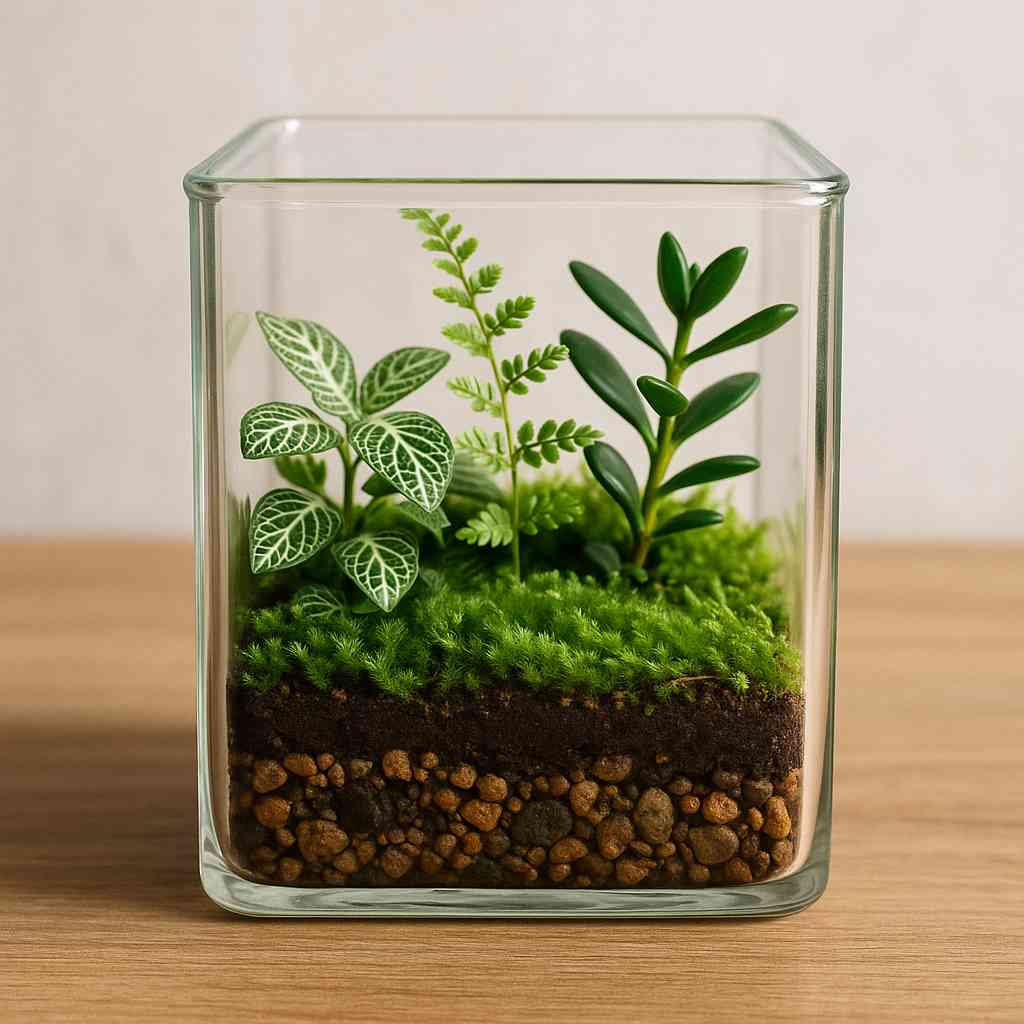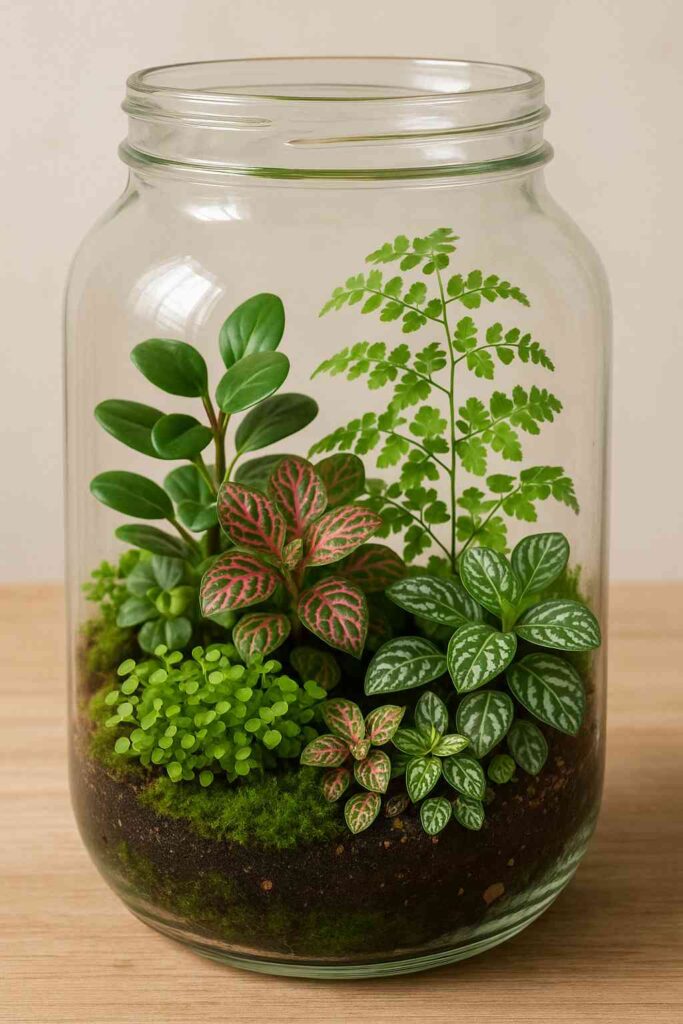Terrariums are known to improve your home aesthetics with little care. You can bring garden vibe into your living space without much mess.
But, one of the common questions while caring terrariums is how often to water them?
Unlike outdoor plants, bottle garden or terrarium plants operate on a fine balance. Too much watering can lead them to rot or mold and you know negative impact of underwatering.
Though watering needs of every terrarium plant is different, in this article you’ll learn a common practice to water terrarium in the right way.
As a general rule, you should water open terrariums for every 3 weeks and closed terrariums can go for 2-3 weeks depending on the container size and environment of your plant.
When to Water Terrariums?

Unlike regular indoor plants, terrarium plants don’t follow a fixed watering schedule.
To be able to water terrarium, you must know when to water it. Like in case of potted plants you can just insert your index finger into the soil and check for the moisture.
Similarly, in terrariums you should ensure the plant needs to be watered.
Else, you may end-up overwatering terrariums, which can be disastrous. Excess moisture promotes mold, fungus, and root rot, especially since the sealed environment lacks airflow to dry things out.
Likewise, underwatering is just as risky, causing plants to wilt, brown, and decline fast. Once the internal water cycle breaks, there’s no backup moisture source to sustain plant life.
As there’s no natural backup like rain or regular airflow to help. That’s why spotting early signs of water imbalance is crucial. A small delay or oversight can disrupt the entire ecosystem.
1. Absence of Condensation on Glass Walls
The most reliable watering indicator is complete absence of glass condensation. Healthy terrariums show light misting or droplets, especially mornings.
No condensation signals disrupted water cycles and insufficient soil/air moisture. Normal daily variation occurs, but no condensation for several consecutive days, particularly mornings, clearly indicates watering is needed.
2. Soil Appears Dry and Pulls Away from Glass
Visible soil dryness signals immediate attention needed. Light-colored, cracked, or visibly dry surface indicates compromised moisture balance.
Soil pulling away from glass shows moisture-induced shrinkage, creating air gaps that disrupt root contact and damage delicate systems. Severe contraction affects future water distribution.
Dropping soil levels from compressed organic matter can become irreversible, making prompt watering intervention crucial for ecosystem recovery.
Also Read: 17 Best Low Light Terrarium PLants
3. Plants Show Signs of Wilting or Stress
Plant stress indicators provide obvious visual cues requiring water.
Wilting appears first—leaves droop, lose posture, become less firm. Leaf changes include duller color, brown edges; succulents show wrinkled leaves, tropicals display curling.
Growth patterns shift: slowed/stopped development, smaller leaves, premature bud dropping as plants redirect energy toward survival rather than reproduction.
4. Moss Appears Brown or Brittle
Moss condition serves as an excellent early warning system for terrarium hydration. Healthy moss appears vibrant green and feels soft/springy.
Brown tips or edges indicate moisture below critical thresholds. Brittle or crunchy texture signals advanced dehydration requiring immediate attention—moss enters dormancy.
While recoverable with rehydration, prolonged brittleness causes permanent damage to these important ecosystem components.
5. Reduced Growth Rate or Yellowing Leaves
Growth pattern changes provide subtle clues about terrarium water needs before obvious stress appears. Plants slow growth rates, conserving energy for survival. New leaf development becomes slower, smaller, taking longer to unfurl.
Existing leaves show slight discoloration progressing to yellowing. Yellowing begins with older leaves as plants redirect resources, indicating water cycle restoration needed.
How Often to Water Terrariums?
Terrarium watering frequency depends entirely on the container type and environmental conditions.

Closed terrariums with airtight seals can sustain for 2-5 months between waterings due to their self-sustaining water cycle.
But, open terrariums require attention every 1-3 weeks because of constant moisture evaporation.
Instead of relying on rigid watering schedules, successful terrarium care need regular observing visual cues like condensation levels, soil moisture, and plant condition to determine when watering is actually needed.
Closed Terrariums
Closed terrariums need watering only 2-4 times yearly due to self-sustaining water cycles. Airtight gasket seals create efficient internal cycles, often requiring watering just once per year with minimal external intervention.
Semi-Closed Terrariums
Semi-closed terrariums with cork lids need watering every 2-3 months due to imperfect seals allowing moisture escape.
Slight air exchange disrupts the internal water cycle, requiring more frequent attention than fully airtight systems.
Open Terrariums
Open terrariums require watering every 3-6 weeks due to constant air circulation and rapid evaporation.
Without lids to trap moisture, these systems lack natural condensation cycles, requiring more regular monitoring than sealed environments.
Factors that Affect Watering Frequency
1. Container Size and Material
Larger terrariums generally hold moisture longer than smaller ones. The greater soil volume and plant mass create more stable humidity levels, extending time between waterings.
Container material also matters—glass provides better moisture retention than plastic, while acrylic lids may not seal as effectively as glass.
Plant Species Requirements
Different plants have varying water needs that affect overall terrarium frequency:
- Succulents and cacti: Prefer drier conditions, requiring water approximately once per week in terrarium settings.
- Tropical plants and mosses: Thrive in humid environments, needing water every alternate day in some configurations.
- Bonsai plants: Typically require alternate day watering when housed in terrariums.
- Fast-growing species: Use more available water for growth, necessitating slightly more frequent watering compared to slow-growing varieties
2. Environmental Conditions
Room temperature, humidity, and light exposure significantly impact watering frequency. Terrariums placed in sunny windows may need more frequent attention due to increased evaporation, while those in dimly lit areas retain moisture longer.
High ambient humidity reduces water loss, while dry environments accelerate the need for watering.
Seasonal changes also affect watering needs. Winter heating systems can create drier indoor conditions, potentially requiring more frequent terrarium maintenance, while humid summer conditions may extend watering intervals.
3. Observation-Based Watering Schedule
Regular Monitoring Protocol
Rather than following a rigid schedule, check your terrarium every 2-3 weeks
and document observations. Note substrate moisture levels, condensation presence, and plant appearance. This approach helps you understand your specific terrarium’s unique water cycle patterns.
Taking photographs can provide valuable reference points for future comparisons. Visual documentation helps track subtle changes that might not be immediately apparent during routine checks.
Adaptive Scheduling
Every terrarium is different, making universal watering schedules ineffective. Factors like seal quality, plant selection, container size, and environmental placement create unique requirements. Start with general guidelines but adjust based on your specific terrarium’s behavior and responses.
Learn from experience by paying attention to how your plants respond to watering and adjusting accordingly. Over time, you’ll develop intuitive understanding of your terrarium’s needs and optimal watering timing.
Seasonal Considerations
Winter months may require slight increases in watering frequency due to indoor heating systems reducing ambient humidity. Summer conditions might extend watering intervals due to higher natural humidity levels.
Monitor environmental changes in your home, such as new heating systems, air conditioning, or seasonal light variations, as these can affect your terrarium’s water cycle and require schedule adjustments.
The key to successful terrarium watering lies in patient observation rather than predetermined schedules. By understanding your specific terrarium’s unique characteristics and responding to its actual needs rather than calendar dates, you’ll maintain a thriving ecosystem that can flourish for years with minimal intervention.
How to Water Terrarium Plants?
Not just timing proper watering technique is crucial for terrarium success, requiring precision and patience rather than traditional plant care methods.
Watering Methods
Use a spray bottle or misting device for controlled water application. This prevents soil disruption and allows gradual moisture absorption. Avoid pouring water directly onto plants or soil, which can cause root rot and disturb the delicate ecosystem balance.
Apply water slowly in small amounts, allowing each spray to absorb before adding more. Target the soil surface rather than leaves, as excess moisture on foliage can promote fungal growth in humid terrarium environments.
Technique and Timing
Water early morning when temperatures are cooler, mimicking natural dew patterns. This allows plants to absorb moisture before daily temperature fluctuations occur.
Start with minimal amounts—typically 1-2 tablespoons for small terrariums, adjusting based on container size. Monitor for 24-48 hours after watering to assess moisture distribution and condensation levels.
Post-Watering Monitoring
Observe condensation patterns on glass walls within hours of watering. Light misting indicates proper hydration, while heavy condensation suggests overwatering. Watch for plant responses over several days—healthy plants should appear more turgid and vibrant.
Remove any standing water immediately if pools form, as stagnant water breeds harmful bacteria and fungi that can destroy your terrarium ecosystem.
Best Water for Terrariums
Distilled water is ideal for terrariums due to purity and lack of harmful chemicals/minerals that damage sensitive plants and cause glass streaking.
Deionized water offers a budget-friendly alternative with similar benefits.
Rainwater provides the most natural option, mimicking native environments—algae in stored rainwater is normal.
If using tap water, let sit 24 hours to evaporate chlorine, though minerals remain problematic.
Avoid mineral/spring water containing the same harmful minerals as hard tap water that accumulate and damage plant roots over time.
Conclusion
Watering a terrarium isn’t about frequency—it’s about attentiveness. Every terrarium is unique, and its watering needs depend on the type of container, plants, environment, and even seasonal changes.
Instead of following a rigid schedule, observe your terrarium regularly for signs of dryness or excess moisture.
By learning to recognize the subtle cues—like changes in soil, condensation, or plant health—you’ll develop an intuitive rhythm for when to water. This careful, responsive approach ensures your miniature ecosystem stays healthy, balanced, and thriving.

Khaja Moinuddin, a computer science graduate, finds joy in gardening and homesteading. Join him on this blog as he shares his experiences in homesteading, gardening, and composting